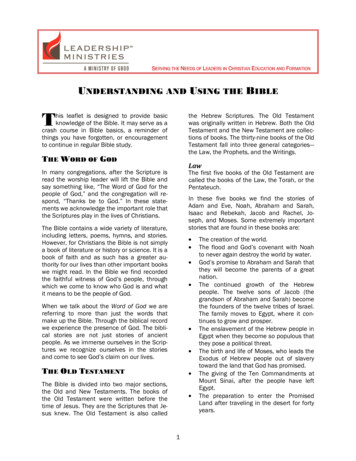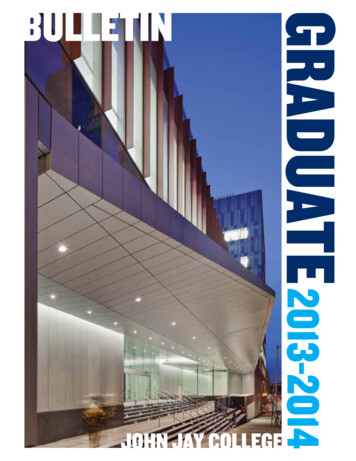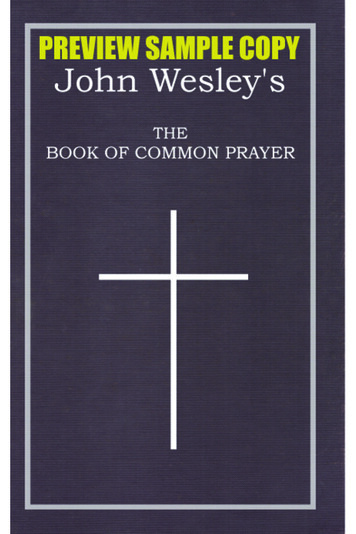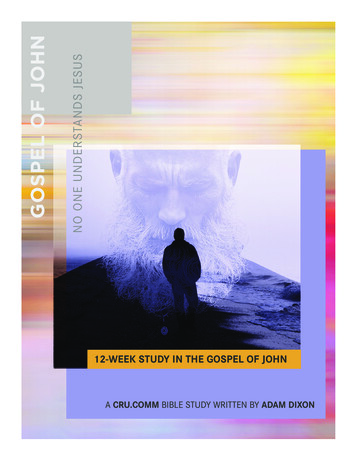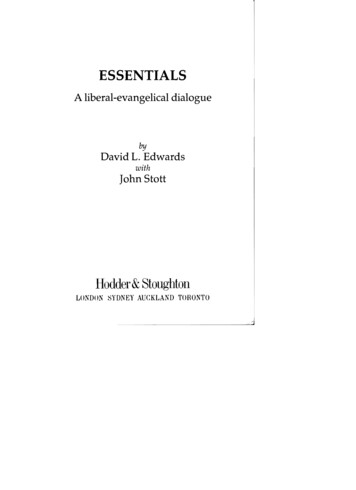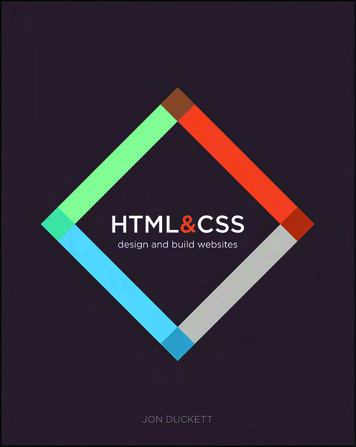
Transcription
By John GeraghtyISBN 978-0-9933558-0-6Copyright 2015 Green Olive Publications LtdAll Rights Reserved
MANUALTable of ContentsIntroduction . 1How to Work rough the Course . 2NOTESPiano Keys .5Treble Clef . .6Treble Clef—Random Notes . .8Bass Clef. .9Bass Clef—Random Notes .11iii
The Complete Classical Piano CourseIntroductionThanks for downloading the free E-book on The Complete Classical Piano Course!This online course has been extracted and edited directly from The Complete Classical Piano Course,which includes; Book One—Manual, Book Two—Technique, Book Three—Practice Notes and BookFour—Music, 3 audio CD's and over 1000 HD online videos. Some PDF pages will be shorter thanothers simply because this online course will "drip feed" information from the complete course.The mp3's are taken directly from the three audio CD's found within these books. NOTE: The tracknumbers in the PDFs will not be in numberical order. A selected number of videos have been added tosupplement this online course.As a private piano teacher for many years, I have developed an approach to learning the piano that isfast and effective. My strategies and tips have worked for every student from the ages of 5-75 years old.Contrary to what people say, you don't have to be young to start playing the piano. In fact, I havefound that adults learn faster than children. The reason for this is simple.Adults follow instructions better than children.A Student should not worry about learning.It is the teacher's job to teach him or her in a way that the student can understand.Having weekly lessons with a private teacher is a great way to learn, but if you are dedicated and selfmotivated enough, then there is no reason why you cannot learn by yourself. After all, a teacher usuallyteaches a student for an hour per week and the rest of the week that student would be practising by hisor herself.1SFWFOUJPO JT BMXBZT UIF CFTU DVSF .BOZ PG UIF iQMBZJOH GBVMUTw UIBU TUVEFOUT NBLF XIFO QMBZJOH UIFQJBOP BSF OPUFE UISPVHIPVU 5IJT XBZ ZPV XPO U IBWF UP NBLF UIF TBNF NJTUBLFT ZPVSTFMG Two reasons why Classical piano is the best way to start learning piano:1. You will understand how to read the music properly: Playing classical music is more formal thanplaying pop or jazz music. Apart from some variations in tempo (speed), the rhythms should beplayed in strict time, thus teaching you how to play the music correctly. Also, many of the tunesmay not be familiar to you, so you cannot rely on learning the music by ear alone.2. You will learn technique: When students learn by themselves with no one to watch over them,technique tends to be overlooked. I am a firm believer of learning good technique when it comes toplaying the piano, so this area is stressed throughout the course. There are two techniqueprogrammes that will specifically help you with technique, taking you to an advancedlevel. The music that comes with this online course have been chosen specifically to help you withcertain techniques that are always found in classical piano. They also show finger markings andthese are there to help keep your hands in the correct position. I rarely see any finger markings inpop or jazz books, so basically you have to work those out for yourself. But, the foundation you gethere will help you play any style.FINal NOTE:5IFSF BSF UISFF XBZT JO XIJDI B TUVEFOU DBO MFBSO #Z SFBEJOH MJTUFOJOH BOE XBUDIJOH 5IJT POMJOF DPVSTFXJMM HJWF ZPV BMM UIFTF UISPVHI UIF 1%'hT .1 hT BOE WJEFPT Enjoy!1
Book One ManualHow to Work Through the CourseThis course is designed for the following students 1. Beginners wanting to learn from the beginning to an intermediate/advanced standard ofreading/playing.2. Students that played “a long time ago” and now wish to start again.3. Intermediate students that can read well, but would like to learn new skills.4. As a training guide for all levels of piano teaching.For Beginners and Students that have played a long time ago—start at the beginning and follow the STEPS outlined on page 4.For Intermediate Students—start at the beginning and follow the STEPS outlined on page 4.In my experience, even advanced players forget things!However, because everyone learns differently, ask yourself the following question:What type of student are you?Will you practice:1. Methodically with daily practice?or2. As and when, 2–3 times per week?For both parties, there are only two main sections that you will need to use: PDF: Manual andMusic. PDF: Practice Notes: Will give you extra help when playing the PDF: Music.If you practice and study daily it’s recommended to work from PDF: Technique, as your playingtechnique can only be improved through regular practice.5IF .BOVBM TFDUJPO XJMM CF ZPVS HP UP BSFB UP TUVEZ OPUFT SIZUIN BOE UIFPSZ %JQ JO BT XIFOZPV OFFE UP MJLF VTJOH B EJDUJPOBSZ 5IBU XBZ ZPV XJMM GFFM UIBU ZPV EPO U IBWF UP MFBSO FWFSZUIJOHTUSBJHIU BXBZ The Practice Notes section will guide you throughout each piece in more detail and will point you toother areas of practice to focus on (“Technique”, “Rhythm”, “Theory” or “Aural” training).auRal TRaININGHow to use the music tracks:1. Aural Awareness Training: It is very important that you DO NOT listen to the music before youhave studied it through note and rhythm training. If you do then you are only learning the musicby ear which defeats the purpose of learning how to read music. Once you have learnt the musicand played it for a few weeks, listen to the way I have played the music, whilst you read the musicsimultaneously. You will find that some tracks were not played strictly as written! This is only oneway that I have interpreted the music—with or without intention. Some of the music will slowdown at the end. By listening, you will have a much better idea of how to play a ritard.2. Use one track as an accompaniment while playing the other hand. Only use this practicetechnique, once you understand how both hands are played separately. Remember that you don’twant to listen to the other track that hasn’t been learnt yet!3. As a double-double-check. Listen to the track only after learning it. If it’s wrong, then correct it.You won’t make the same mistake twice! If it’s correct, then you should feel more confident nexttime. Before listening to the track though, revisit the chapters on “Rhythm” and/or “Theory”relating to the problem or the video relating to the technique.2
The Complete Classical Piano CoursenOtesPianO keysFind every D on the piano—they canbe found between the two black notes.DDNow find the C and E either side of theD note.C D EC D EFind F— it is the first white note justbefore the three black notes.C D E FC D E FNow find A and B, and then G and A,forming the alphabet from A – G.A B C D E F G A B C D E F G A BRepeat this across the entire keyboard.SHaRPS (#) aND FlaTS (b)—The Black NotesC# D#CDEDb EbC# D#Db EbCDECDEDb EbC# D#CDEGb A b B bF# G# A#FGABThe first black note just to the right of any white note will make it a sharp. The first black note just to theleft of any white note will make it a flat. This means that each black note can be called either a sharp or aflat.How to practice finding the notes: Without looking down at the keys; play any note and then look downand see if you can recognize the note quickly. If you pause, then keep practising before moving on.Watch “Stage 1” from Video Basics.5
Book One Manual& Treble CleflEaRNING THE NOTESTreble clef notes are played with the right hand (R.H.). The 5 lines and 4 spaces make up the stave. Studythe following.SpacesIf it’s in the SPACE, it’s the word FACE&wFwwwACELinesIf it’s on the LINE, it’s the RHYME&wwEveryGoodwwwBoyDeservesFoodMiddle C and D&wwMiddle CDlOCaTING THE NOTESFace—with Middle CWhen sitting in front of the piano, the C that is nearest to you at the centre is Middle C. Always sit infront of Middle C.For keyboard players with less than 88 keys, Middle C is likely to be more to the left rather than in thecentre. So when you are sitting in front of Middle C, you will find that you will have more notes to theright rather than the left.FCACEmiddle C&wCwFwwwACE6
C TheD ECompleteF G A ClassicalB C D EPianoF GCourseA B C D E F G A BFACEEvery Good Boy Deserves Food—with Middle CFACEC D E F G A B C D E F G A B C D E F G A BC EGBDFmiddle C&wwwCEGwwBDwFEG FB AD CFD E F G A B C D E FAll Together with Middle CECD E F G A B C D E Fmiddle CE& w w wCDEGB C DFw w ww w w wFGAWatch “StageD5” fromBasics.E FVideoG ABBCDEwFCC D E FOne OctaveCCmiddle CFrom Middle C to the next C higher (to the right) or lower (to the left) is one octave. An octave can befrom any note, e.g., B to B or F# to F#. You can, of course, have more than one octave in either directionon the keyboard. This course covers up to four octaves.One Octave&ww7
Book One Manual& Treble Clef Random NotesIt is important that you say the following notes without pausing; otherwise you will find the musictoo hard to play. Don’t carry on with the course until you can do this easily. Practice each of the threesections on their own, then try all three without stopping. Set the metronome to 80 (see RHYTHM) andsay each note to each click, and then try at 90. Then go backwards.&wSpaceswww& wwwwwwwwwwwwwwwwwwwWatch “Stage 2” from Video Basics.Lines& w& wwwwwwwwwwwwwwwwwwwwwwwwWatch “Stage 3” from Video Basics.&w& w& wAll TogetherwwwwwwwwwwwwwwwwwwwwwwwwwwwWatch “Stage 4” from Video Basics.TIP! If you still find it hard to think of the note, close your eyes and imagine the treble clefand the five lines and then ask yourself these questions: What note is on the top line? Bottom line?Middle line? Second line (from the bottom)? Fourth line? Do this for the spaces:(What is the top space, bottom space, second and fourth space? etc.) and then the lines and spaces together.The more it’s in your head, the easier it will be to see it on the stave. You can practice this anywhere.8
The Complete Classical Piano Course?Bass CleflEaRNING THE NOTESBass clef notes are played with the left hand (L.H.) Study the igwwwDogsFightAnimalsLedger Lines Above and BelowMiddle C in the Bass Clef is written above the stave. The note E is the start of the word Every for the“Right Hand” rhyme—Every Good Boy Deserves Food.wwwMiddle CDE?Below shows how B (new note), C, D and E are written for each hand at the same pitch, i.e., the samenote. Upper notes R.H. and lower notes L.H.&w? wwwwwwwBCDEThe example below shows the layout of these four notes in relation to the keyboard.BCD Emiddle C9
Book One ManualDlOCaTINGGTHE BNOTESFAAll Cows Eat Grass—with B and Middle CA?CwwACEBBGB CD E middle CwwwwEGBCD EGreat Big Dogs Fight Animals—with Middle CG A B C D E F G A BGBDFAGBDFACmiddle C?wwABGCwEDA MiddleCAll Together—withCEwGBFGG A B C D E F G A BwwACBCmiddle C?G wA B wC D Ew F Gw AGABCwBDwwwwwwEFGABCWatch “Stage 12” from 7JEFP #BTJDT10
The Complete Classical Piano Course?Bass Clef Random NotesPractice the same way as you did for the treble clef setting the metronome from 80–90.Spaces? w? wwwwwwwwwwwwwwwwwwwwwWatch “Stage 9” from 7JEFP #BTJDT Lines?w? wwwwwwwwwwwwwwwwwwwwwWatch “Stage 10” from 7JEFP #BTJDT All Together? ww? ww?wwwwwwwwwwwwwwwwwwwwwwwwwWatch “Stage 11” from 7JEFP #BTJDT TIP! If you’re having troubleremembering the bass clef notesthen imagine the note in the trebleclef in the next space/ line higher.CwF? ww& wCFAwwADwwDWatch “Stages 13 – 15” from Video Basics before starting Symphony No. 9 “From the NewWorld.” AVAILABLE IN MONTH 3.11www
MANUALTable of ContentsRHYTHMIntroduction to Rhythm .1The Metronome. .2/4 Time Signature .3iii
Book One ManualrhythmintrODuctiOntOrhythmtrack 1Listen to the track and clap the rhythms like an echo. Some are short and others are longer. There will bea gap between each rhythm while you clap.What you clapped is indicated in brackets.jj& œœœœœ œœœœœ œ œ œ œ œ œ œœ‰ œ œœ‰ œ œ œœœ œ ‰ œ œ œ œœœ œ ‰ œ œLooks complicated doesn’t it?By listening to the rhythm you clapped, it probably happened without hesitation.Question: Can you clap the rhythm below?& œœ œœ‰ œœ œ œœ‰ œœœ œ œœœ œœ œœ œœœœœ œ œMost of the music that you will play in this course will be music that you may not be familiar with.This is because it’s important for you to learn how to read what’s written on the page,rather than learning to play the music by ear.TIME SIGNaTuRESTime signatures are the numbers found at the beginning of each piece of music. The top number tells youthe number of beats within each bar. The lower number tells you the type of beat—explained later onin /4, and /8 time
Some PDF pages will be shorter than others simply because this online course will "drip feed" information from the complete course. The mp3's are taken directly from the three audio CD's found within these books. NOTE: The track numbers in the PDFs will not be in numberical order. A selected number of videos have been added to supplement this online course. As a private piano teacher for


